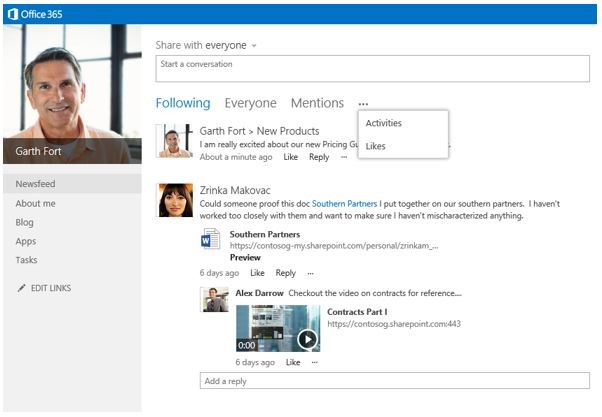Optimizing Your Website for Collaboration and Interactivity

Most people who have used SharePoint have done so through their office intranet. But SharePoint also has the ability to be a content management system for building external websites, and its permissions make it easy to assign roles to different people depending on who is in charge of particular sections of the website.
This allows for seamless contributions by multiple authors within an organization, who may each have been assigned to different sections of the website. Here are a few features SharePoint has that will help you set up a new company website from scratch or move your existing content to a new website.
1. Easy-to-use content editing tools look like other Microsoft Office products
As long as you or your employees are familiar with Microsoft Word and other Microsoft Office products, they will be familiar with the text editing tools in SharePoint. And getting people to edit sections of website content is much easier if you don’t need to train them to navigate a completely unfamiliar interface:

A nice feature of SharePoint is that you have the ability to click on the Edit Source button and change the html code directly, rather than only working with the WYSIWYG (What You See Is What You Get) shown on the page. This enables end users who are comfortable with html coding to choose this option to make formatting changes on the page, while still allowing those who prefer WYSIWYG to avoid dealing with html code.
The Page editing toolbar contains functions that are a bit different than those in Microsoft Word (because you are editing a web page rather than Word document), but it still contains a similar look:

People can try out different page layouts with the click of a button, and go back to the original page layout simply by selecting it or exiting without saving the page.

These tools make it easy for anyone to manage your website and its content.
2. The look and feel of your website can be customized easily using templates
Just like Microsoft PowerPoint has different templates users can choose and then customize, so does SharePoint. SharePoint’s site menu enables users to change the look and layout of the website without having to know anything about html or code.

For example, if you’re creating a website for a sushi restaurant, choose the Sushi Black design, or start with a basic template and then use your own image in the background. The templates are generic enough that you’ve probably unknowingly visited a number of websites that use SharePoint.

SharePoint can be as customized as you want: if you want to start simple by using the built-in design templates and then eventually add more features, that’s completely up to you and your end users’ level of comfort.
3. SharePoint social plugins, App Parts and Web Parts can be added to customize your website
Anyone who owns a smartphone knows that most software and hardware are now built around apps. Apps (applications) enable customizability by adding features to a base framework. For example, if you own an iPhone, you know that when you purchased it, there were standard apps on your phone, such as your camera, photos, messages, calendar, notes, and mail. And you could go to the App Store to get additional apps such as Google, Facebook, LinkedIn, and so forth. SharePoint is set up in a similar way because you can choose to insert social plugins, App Parts, and Web Parts, simply by clicking on the appropriate button from the Insert tab:

Social plugins can be purchased from the SharePoint Store after clicking on the Social Plugins button. Many of these are free, although some will have a cost listed in their description. For example, one freely available plugin is OneBit Survey Master, developed by OneBit Software Ltd, which lets you create surveys, questionnaires, polls, and feedback forms to put on the website and then analyze and publish the results to your website. These are great for product reviews, feedback forms, and so forth.
Plugins, like apps, are usually created by non-Microsoft developers or companies. OneBit Software, for example, is not a Microsoft company, but it has created an app available through the SharePoint Store that can be used with Microsoft’s product. Apps for iPhone work in a similar way: some of the apps in Apple’s App Store are made by Apple, but most are not. This customizability through third-party apps is what many people see as the future for not only mobile devices but also websites, and SharePoint is set up to allow you to do this.
In addition to social plugins, SharePoint users can also add App Parts and Web Parts to their pages. SharePoint’s built-in App Parts mostly consist of document lists and picture libraries, but along with Web Parts, they can be customized by developers and added as options for your page. For example, you can add a Web Part called Recently Changed Items to your page, which will display a list of any documents or pages in your site that have recently been updated.

There are, of course, terms that SharePoint users will have to become familiar with, even if they are already used to Microsoft products. For example, SharePoint uses the term site to refer to each main section within an overall website, and you can also add subsites and pages to each site. Since most people think of the word siteas referring to the entire website, this can be confusing. However, it is a key method of how SharePoint is able to divide the overall website into sections that can be managed by different users with unique permissions, and once users are familiar with the basic terms, it becomes clearer whether to add a new site or a new page and how to structure pages using a hierarchy.
The points above were just a highlight of how SharePoint can be used for your company website. For more information, check out Microsoft’s Getting Started with SharePoint 2013 or contact us and we’d be happy to help set up your website or train your employees how to use it.
Leveraging Your Office Intranet for Employee Connection & Collaboration

Many businesses today have an intranet, which often looks like a website you would find on the Internet, but it can only be accessed by people within the company. In their early days, intranets looked more like a file system than a website because they were mostly used for file sharing and storage.
Today, intranets have evolved so that employees can access information via a web interface similar to how they would do online banking or connect with people via social media. They can also collaborate on large-scale projects and engage with coworkers who may be hundreds of kilometers away.
But in spite of this, many companies’ intranets are still being used the same way they were 10-15 years ago, even though they are capable of being so much more than a document storage system. Here are some features of intranets you can review to check whether your office intranet is being used at its full potential and better leverage it if it’s not.
1. Intranets can be used like they’re an internal social networking site
When the Internet shifted to the social web in the mid-2000s with the surge of Facebook, Twitter, MySpace, and other social networking sites, some companies saw an opportunity to improve internal communications by incorporating social media characteristics in their intranets.
However, this doesn’t mean that employees leaped at the opportunity to interact with each other through the company intranet. Also, sometimes these features didn’t work properly or employees felt their interactions with coworkers would be tracked. But as people became more comfortable interacting online outside of the workplace, they started to see the potential for social networking in office intranets, and intranet software such as Microsoft SharePoint 2013 now has many features that can make it easy for your employees to interact with each other through their company intranet.

In Microsoft SharePoint 2013, employees have profiles and landing pages that are similar to those in Facebook and other social media. They contain newsfeeds with updates on the activities of coworkers and documents you are following, with the ability to share updates with everyone or just your followers. The About Me page allows employees to share information about themselves and coworkers to see where they fit in the organization.

With software such as SharePoint 2013, employees can share more information about themselves than just their job title and company bio; tag or mention coworkers; follow people, documents, and posts; and build their own internal social network within your organization. What a great way to help your employees see how they fit within your organization and how important they are for helping everyone do what they do.
For more information about SharePoint’s intranet capabilities, see Microsoft’s SharePoint 2013 IT Pro Training Presentation, available in the Microsoft Download Center.
2. Intranets can be designed and customized to match your company’s unique needs
Does your intranet contain features nobody uses, or are there functionalities you could add that would bring people to your intranet rather than email, shared folders, or external social media?
You might want to consider doing some user testing and then redesigning the look and layout of your intranet according to their feedback, adding/removing features, and so forth. For examples of award-winning intranet sites, check out Nielsen Norman Group’s list of 10 Best Intranets of 2015, including two that also won the “Mobile” track award (Verizon Communications) or received an honourable mention (Adobe) in Digital Workplace Group’s My Beautiful Intranet 2014. You can also take a look at Digital Workplace Group’s award winners for examples of what effective intranets look like and how they might evolve in future.
3. Intranets make it easy to manage document versions and search for information in one secure, centralized location
By storing all documents in one central, easily accessible location, companies can eliminate confusion about whether documents are the most up-to-date version, a draft or final version, or checked out for editing.
If you studied how much time employees spend looking for things and emailing each other for documents, or redoing each other’s work in the same document, and then added this up over the year, you would see how much intranets can save in employee time and productivity. Also, instead of using Google or your external website to search for information about your company or its people, your employees can use the search filters in your intranet to get more complete and accurate information than they would using the Internet. And, if employees do not need to download information externally, or store files on their own devices when they are on the road or working from home, this also helps keep your company’s information secure.
4. Intranets can replace internal newsletters (saving paper and email clutter!)
Most intranets enable you to post news items on a home page and then store previous news items below. Rather than sending out a newsletter biweekly or once a month, news items can be updated regularly on the intranet and be the first thing employees see when they open their web browser.
There can also be separate sections on the home page for announcements, virtual water cooler discussions, staff blogs, updates from the CEO, and so forth. In essence, everything that would have normally been included in a newsletter can be put on the office intranet, but unlike newsletters that are printed or emailed, intranets enable people to comment on articles, add congratulatory messages to announcements, and so forth.
This same level of interactivity just isn’t possible across an organization without one (you might have conversations in the lunch room or hallway, but these informal conversations might not travel across departments like they would in an organization-wide intranet).
5. Internal communications plans can make a huge difference in whether people use their office intranet
Even though intranets can be used for social networking, managing documents, and sending news across an organization, people often stick with what they’re used to. If they normally store documents on their own computer and then email them to coworkers when they’re needed, they may keep doing this even if it would be easier to store these documents on an intranet. And if they’re not used to sharing information about themselves at the office, they may not be comfortable doing so through their office intranet (even if they already use Facebook, Twitter, or other social media outside the office).
Developing internal communications policies, along with plans for encouraging employees to use the office intranet, can go a long way in ensuring it gets used at its full potential.
Whether you’re in charge of internal communications, an IT professional maintaining your organization’s intranet, or an employee whose organization has an intranet, you can ask yourself whether your organization is using its intranet at its full potential by reviewing the five categories above. You may be surprised at how much you can make changes or offer suggestions that will improve your organization’s efficiency and employee connections.
The Top 10 Benefits of Certification for IT Professionals
Most IT professionals have been working in their fields for years and may wonder why it would benefit them to get certification in something they’ve already been doing. Certification usually requires taking a training course and then passing an exam, or at minimum challenging the exam and passing it without taking a course. These courses and exams cost money in addition to the time that needs to be scheduled for them. Sometimes employers will pay for these courses, and sometimes they won’t. So, why spend the time and money to get certifications? Here are the top 10 reasons you should consider doing just that.
1. Many companies use certifications as an easy way to demonstrate your abilities.
Certifications can be used to demonstrate levels of ability that may otherwise be hard to observe. However, the way an organization uses certifications can vary. Cushing Anderson, a program vice president for International Data Corporation (IDC)’s Project-Based Services, notes that “because certification sponsors haven’t articulated the specific competence (and performance benefits) of certification holders, enterprises have had to develop their own value proposition for certification.” In other words, certifications show that you have certain abilities, but the impact of these abilities may be measured differently by each organization. It’s important to familiarize yourself with how your organization regards different certifications in your field.
2. Certifications do help you get hired.
According to the April 2012 Microsoft Certification Program Satisfaction Study, 91 per cent of hiring managers include certification as part of their hiring criteria. However, some companies have made certifications a priority for their staff only when they are contractually or legally obligated to have them. Therefore, some job advertisements may list certifications as being an asset rather than a requirement. Even though the certifications listed in job advertisements can vary by company, they do show your abilities regardless of whether that particular certification is listed in the job advertisement.
3. Certifications increase your earning power.
According to the Certification Magazine 2013 Salary Survey, 66 per cent of individuals surveyed reported that they directly attributed a raise to obtaining a new certification. Ed Tittel and Mary Kyle, IT professionals with numerous years of experience managing IT projects, state that “certifications are… excellent leverage when seeking promotions. They send a clear message to your employer that you’ve mastered concepts and technologies required for the credential, and that you possess skills and qualifications to perform essential functions on the job.” As mentioned in point #1, though, this may be more prominent in some companies than others.
4. Certifications will earn you more respect from management.
When management knows you have certifications rather than just experience in a particular technology, it increases your reputation within your organization. You will be recognized for being more knowledgeable, and your ideas will be given more attention and respect. Some certifications, such as Microsoft certifications, also have different levels and can show management that you’ve progressed within your field. MTA (Microsoft Technology Associate) certifications are for candidates who are new to technology. They show you are familiar with fundamental technology concepts. MCSA (Microsoft Solutions Associate) certifications show you have the core technical skills required for an IT career. And MCSE (Microsoft Solutions Expert—for IT professionals) or MCSD (Microsoft Solutions Developer—for developers) are more advanced certifications that demonstrate your ability to build solutions across multiple technologies.
5. Some certifications get you membership into communities along with their benefits.
Some of these communities include the Microsoft Certified Professional community (MCP). Benefits provided through this program include being able to use your Microsoft account to access MCP member sites. Check out the Microsoft Learning site for more information on what you can find on member sites, how to use member sites, and FAQs about them.
6. Stakeholders often care about whether an organization has developed a certification.
Microsoft certifications, for example, can show clients that you know about the proprietary systems they are using. They add validity to Microsoft’s products by creating standards for competency. Some non-proprietary products such as those that are open source often do not have certifications. This creates a perception of the product being continually in development, and companies with non-proprietary products who want to show they’ve reached a certain level would benefit from creating certifications for their products.
7. Certifications can be used to demonstrate metrics.
Organizations can use certifications to demonstrate their metrics such as the contract size, time to close, time to implement, equipment performance, help desk calls, and project or client satisfaction (Cushing Anderson, “Impact of Certifications”). In other words, they can use their employees’ certifications to show that they are better than their competitors in completing projects efficiently and effectively.
8. Certifications show you are willing to engage in lifelong learning.
You may have received your degree or diploma in computer science years ago, but taking courses and getting certifications will keep you current and show your manager and potential employers that you’ve kept learning. Many certifications also need to be renewed every two or three years in order to keep knowledge and skills up to date. Holding a current certification credential shows that you have cutting-edge knowledge and updated skills.
9. Certifications make sure you learn everything thoroughly.
Imagine if you never had to write final exams in school. Would you have bothered to go through everything you were taught to make sure you'd learned all of it? You might have, but perhaps not as thoroughly as you would if you had a final exam. That's what certification exams do: they force you to go back and make sure you've learned all of it, and certifications tell others that you've done this as well.
10. Certifications do help you get ahead.
When it comes to career progression, whether it is a mid-career move to a new company or a promotion with your current employer, certifications will help you get ahead. Not just for the increased hiring and earning potential, but also because it shows you are willing to engage in lifelong learning.

